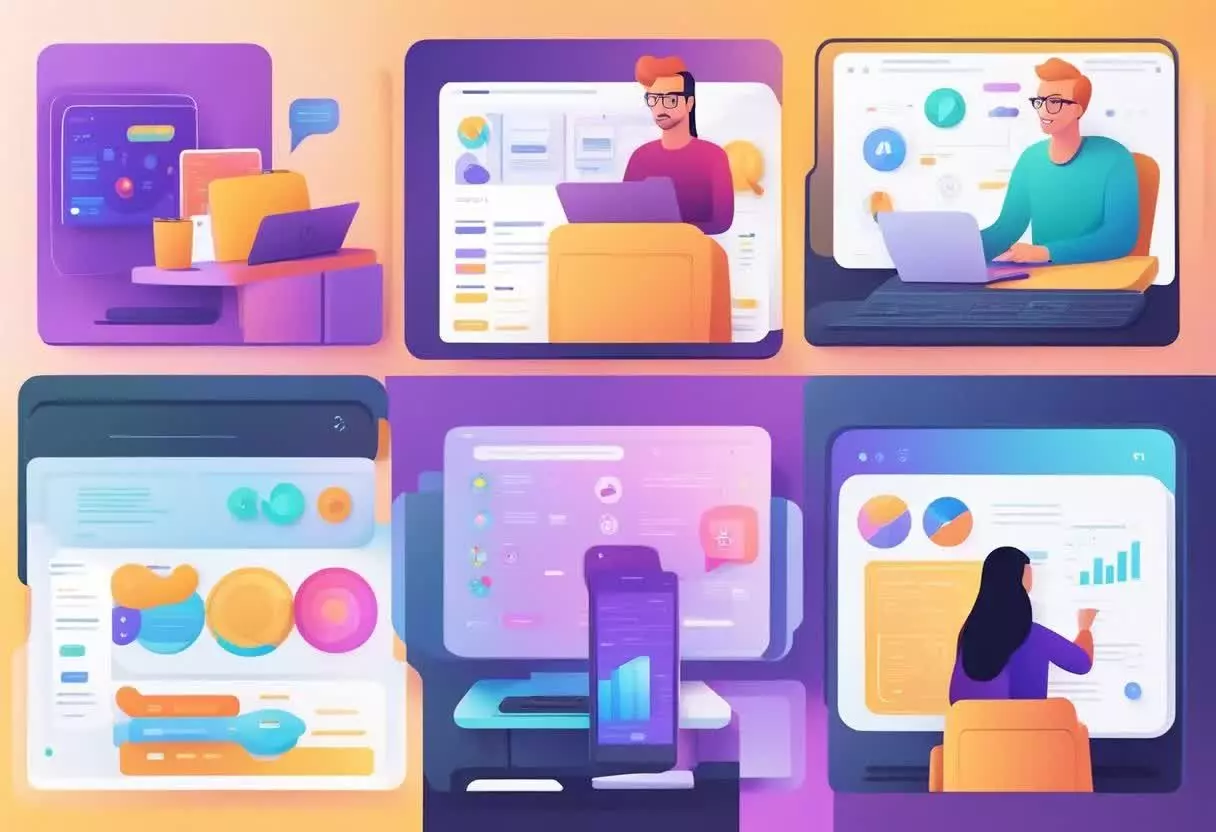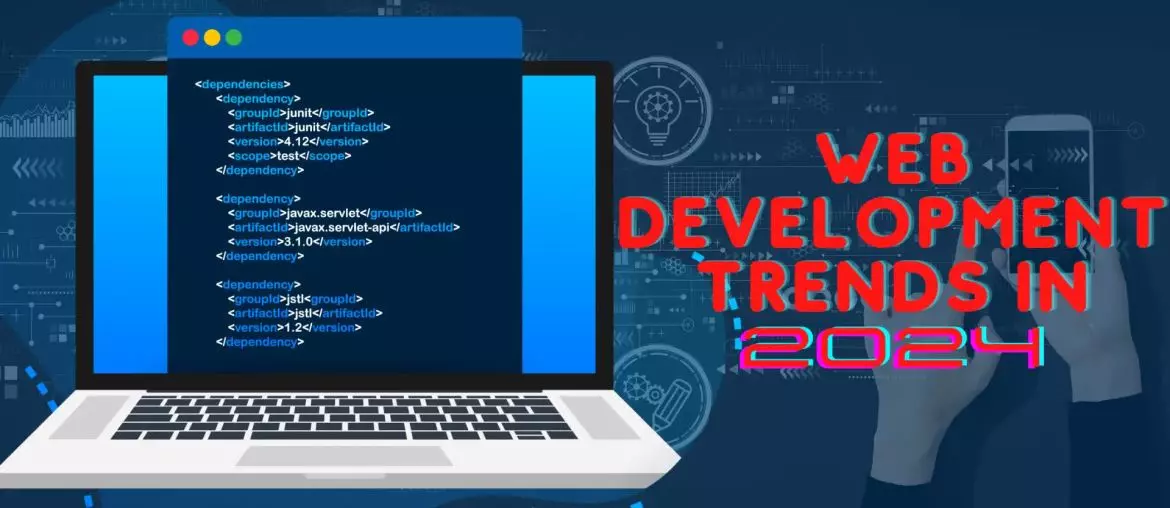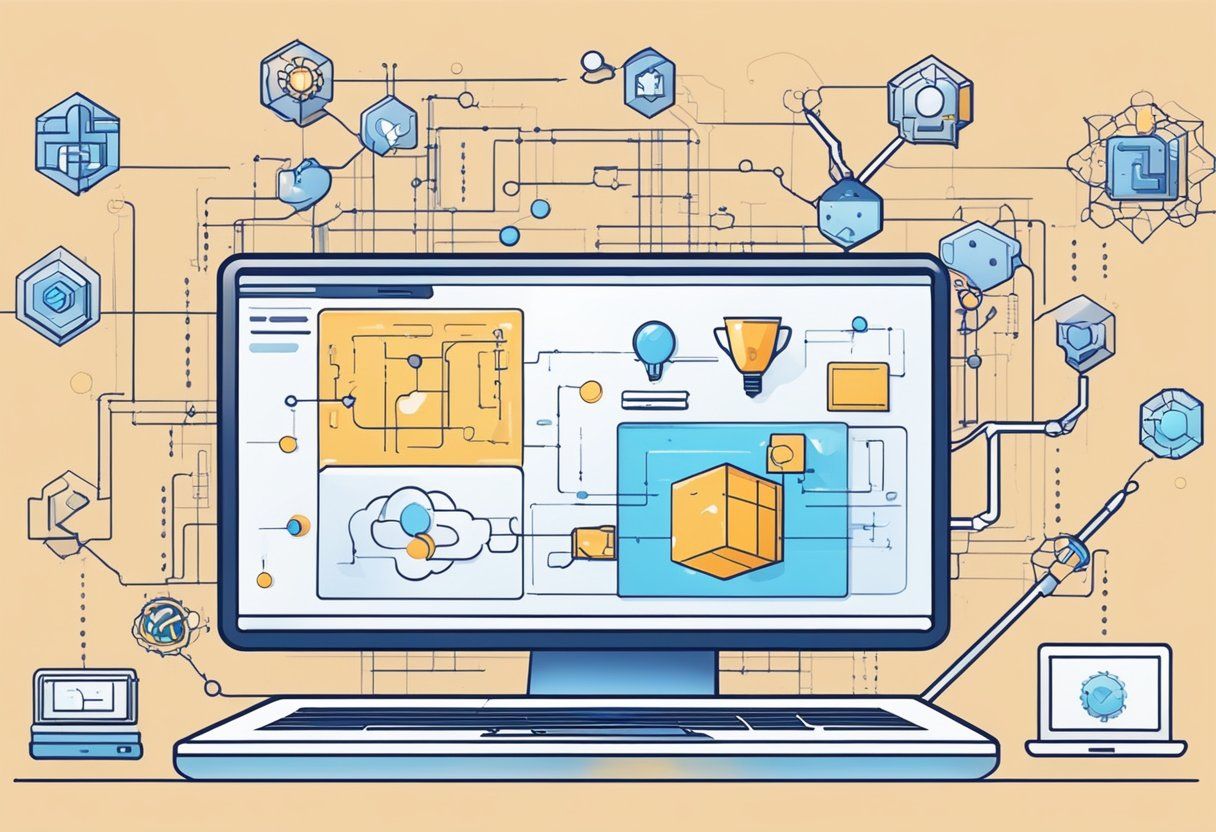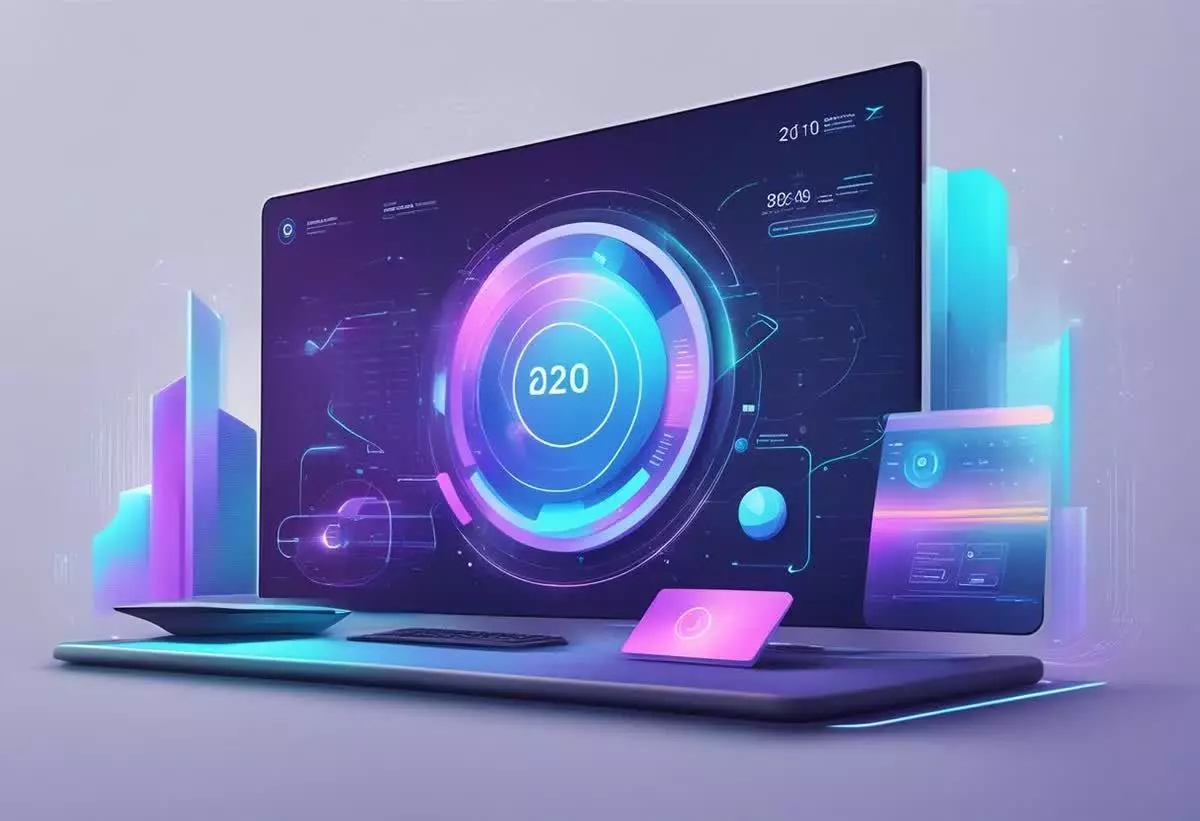Web development trends are constantly evolving, and with the new year fast approaching, it’s time to look ahead to what 2024 has in store. From advancements in front-end frameworks to the rise of progressive web apps, there are several exciting trends to keep an eye on.
One trend that is expected to gain momentum in 2024 is the adoption of AI and machine learning. As these technologies become more sophisticated, they are being integrated into web development to enhance user experiences and streamline processes. Additionally, API-first development is becoming increasingly popular, allowing developers to build more scalable and flexible applications.
Another trend that is expected to continue is the focus on mobile-first design. With more people accessing the internet on their mobile devices, it’s essential for websites to be optimized for smaller screens. This means designing with a mobile-first approach and ensuring that websites are responsive and fast-loading.
Key Takeaways
- Web development trends in 2024 will include the adoption of AI and machine learning, API-first development, and a continued focus on mobile-first design.
- Advancements in front-end frameworks and the growth of Jamstack architecture are also expected to be major trends.
- Enhanced user interfaces with motion UI and the expansion of voice and conversational UI are additional trends to watch for in 2024.
Rise of Progressive Web Apps
Progressive Web Apps (PWAs) are hybrid web and mobile applications that offer lightning-fast loading times, offline capabilities, and a seamless user experience. PWAs are the future of web applications, and in 2024, more businesses are expected to embrace PWAs to engage users across various devices.
Service Workers and Offline Functionality
One of the key features of PWAs is the use of service workers, which enables the apps to work offline. Service workers are scripts that run in the background and can intercept network requests, cache responses, and serve content from the cache. This means that users can continue to use the app even when they are offline, making PWAs ideal for areas with poor or no internet connectivity.
Improved Installation Flow
Another advantage of PWAs is the improved installation flow. Unlike traditional native apps, PWAs do not require users to download them from an app store. Instead, users can simply add the app to their home screen with a single tap. This makes the installation process quick and easy and eliminates the need for users to go through the app store approval process.
User Engagement Features
PWAs also offer a range of user engagement features, such as push notifications, background sync, and the ability to add the app to the user’s home screen. Push notifications are a powerful tool for engaging users and keeping them informed about new content or updates. Background sync enables the app to sync data in the background, even when the app is not open. This ensures that users always have the latest information, even when they are offline.
In conclusion, PWAs are an exciting development in web development, offering a range of benefits over traditional native apps. With the rise of PWAs in 2024, businesses can engage users across various devices with lightning-fast loading times, offline capabilities, and a seamless user experience.
Adoption of AI and Machine Learning
Artificial Intelligence (AI) and Machine Learning (ML) are not new to the world of web development, but their adoption is expected to increase significantly in 2024. The use of AI and ML in web development can help developers create more personalized and efficient web experiences for users. Here are some of the ways AI and ML are expected to be adopted in web development in 2024:
AI-Driven Development Tools
AI-driven development tools are becoming more common in the web development industry. These tools can help developers automate repetitive tasks, such as writing code or testing, and can also provide insights into user behaviour and preferences. For example, AI-powered chatbots can help businesses provide better customer service by answering common questions and resolving issues more quickly.
Personalization and User Experience
Personalization is becoming increasingly important in web development, and AI and ML can help developers create more personalized web experiences for users. By analyzing user data, AI and ML algorithms can help developers understand user behaviour and preferences, and create personalized content and recommendations based on that data. This can help improve user engagement and satisfaction, and ultimately lead to increased conversions and revenue.
Automation in Testing and Deployment
AI and ML can also help automate testing and deployment processes in web development. By analyzing code and identifying potential issues before they become problems, AI and ML algorithms can help developers save time and resources, and reduce the risk of errors and downtime. This can help improve the overall quality and reliability of web applications, and ensure that they are delivered to users quickly and efficiently.
In conclusion, the adoption of AI and ML in web development is expected to increase significantly in 2024. By leveraging these technologies, developers can create more personalized and efficient web experiences for users, automate repetitive tasks, and improve the overall quality and reliability of web applications.
API-First Development
API-First Development is a software development approach that prioritizes the development of APIs before the actual application. This approach ensures seamless integration with other services and platforms, offering a more cohesive user experience. In 2024, API-First Development is expected to be one of the major trends in web development.
Headless CMS Usage
Headless CMS is a content management system that separates the content from the presentation layer. This approach allows developers to use the same content across multiple platforms and devices. With API-First Development, headless CMS usage is expected to increase in 2024. The decoupled architecture of headless CMS and the use of APIs enable developers to create dynamic and responsive web applications.
Integration with IoT Devices
With the increasing popularity of IoT devices, web developers are expected to integrate them into their web applications. API-First Development enables developers to create APIs that can communicate with IoT devices, allowing them to collect data, monitor systems, and control devices remotely. In 2024, we can expect to see more IoT-enabled websites and web applications as businesses and organizations look to connect their devices to the Internet.
Microservices Architecture
Microservices architecture is a software development approach that breaks down a monolithic application into smaller, independent services. With API-First Development, microservices architecture is expected to gain popularity in 2024. By creating APIs for each service, developers can easily integrate them into the web application, making it more flexible and scalable.
In conclusion, API-First Development is a software development approach that prioritizes the development of APIs before the actual application. With the use of headless CMS, integration with IoT devices, and microservices architecture, API-First Development is expected to be one of the major trends in web development in 2024.
Focus on Mobile-First Design

Responsive Frameworks
Responsive frameworks allow developers to build websites that can adapt to different screen sizes and resolutions. This approach ensures that websites look and function well on any device, whether it’s a smartphone, tablet, or desktop computer. Frameworks such as Bootstrap, Foundation, and Materialize provide a solid foundation for building responsive websites quickly and efficiently.
Touch Gestures and Mobile Interactions
Mobile devices have unique interaction patterns that differ from desktop computers. Developers should consider touch gestures such as swiping, pinching, and tapping when designing websites. Mobile interactions such as scrolling, loading, and animations should also be optimized for a smooth and seamless experience. By considering these factors, developers can create websites that are intuitive and easy to use on mobile devices.
Performance Optimization
In 2024, website performance will continue to be a critical factor in mobile-first design. Websites that load quickly and efficiently are more likely to keep users engaged and satisfied. Developers should optimize website performance by minimizing the use of large images, reducing the number of HTTP requests, and compressing files. By focusing on performance optimization, developers can ensure that their websites load quickly and efficiently on mobile devices.
In conclusion, mobile-first design will continue to be a significant trend in web development in 2024. By focusing on responsive frameworks, touch gestures and mobile interactions, and performance optimization, developers can create websites that provide a seamless mobile experience for their users.
Advancements in Front-End Frameworks
Front-end development is the visual presentation of a digital product, and it is constantly evolving. In 2024, developers can expect to see advancements in front-end frameworks that will impact the way they build web applications. Here are some of the most notable advancements that developers can expect to see in 2024.
Component-Based Architecture
Component-based architecture is a design pattern that allows developers to create reusable components that can be used across multiple applications. This approach is becoming increasingly popular as it enables developers to build applications more quickly and efficiently. In 2024, developers can expect to see more front-end frameworks that embrace this design pattern, making it easier to build scalable and maintainable web applications.
State Management Patterns
State management is an essential part of front-end development, and in 2024, developers can expect to see advancements in this area. State management patterns help developers manage the state of their applications, making it easier to build complex and interactive user interfaces. In 2024, developers can expect to see more front-end frameworks that embrace state management patterns, making it easier to build high-quality web applications.
Server-Side Rendering Enhancements
Server-side rendering is the process of rendering web pages on the server before sending them to the client. This approach can improve the performance of web applications, especially those with large amounts of data. In 2024, developers can expect to see more front-end frameworks that embrace server-side rendering enhancements, making it easier to build high-performance web applications.
In conclusion, the advancements in front-end frameworks in 2024 will have a significant impact on the way developers build web applications. By embracing component-based architecture, state management patterns, and server-side rendering enhancements, developers can build high-quality, scalable, and maintainable web applications more quickly and efficiently.
Increased Importance of Cybersecurity
In 2024, cybersecurity will continue to be a critical aspect of web development. As the number of cyber attacks continues to rise, developers need to prioritize security in their projects.
Secure Coding Practices
One of the most effective ways to prevent cyber attacks is to implement secure coding practices. Developers should follow best practices for writing secure code, such as input validation, output encoding, and proper error handling. It is also essential to keep software and libraries up to date to avoid known vulnerabilities.
Data Protection Regulations Compliance
With the increasing number of data breaches, governments are implementing stricter regulations to protect user data. Developers must ensure that their projects comply with data protection regulations such as GDPR and CCPA. This includes implementing appropriate security measures, obtaining user consent, and providing users with control over their data.
Threat Modeling and Response Planning
Threat modelling is a process of identifying potential threats and vulnerabilities in a system. Developers need to perform threat modelling to identify and address potential security risks. Additionally, developers should have a response plan in place in case of a security breach. This includes procedures for detecting and containing the breach, notifying affected users, and restoring the system to a secure state.
Overall, developers must prioritize cybersecurity in their projects to prevent cyber attacks and protect user data. By implementing secure coding practices, complying with data protection regulations, and performing threat modelling and response planning, developers can ensure that their projects are secure and resilient to cyber threats.
Growth of Jamstack Architecture
In recent years, the Jamstack architecture has gained significant popularity among web developers. Jamstack stands for JavaScript, APIs, and Markup, and it is designed to make the web faster, more secure, and easier to scale. This architecture has been around for a while, but it is expected to grow even more in 2024.
Static Site Generators
One of the reasons for the growth of Jamstack is the increasing popularity of Static Site Generators (SSGs). SSGs generate HTML files at build time, which can be served directly to the user without the need for a server. This means that the site can be hosted on a CDN, making it faster and more scalable. SSGs also offer better security, as there is no server-side code that can be exploited by attackers.
Decoupling Front-End and Back-End
Another reason for the growth of Jamstack is the decoupling of front-end and back-end development. With Jamstack, the front-end and back-end are separated, which allows for better collaboration between developers. This separation also makes it easier to maintain and update the site, as changes can be made to the front-end or back-end without affecting the other.
CDN and Edge Computing
Jamstack also leverages Content Delivery Networks (CDNs) and Edge Computing to improve site performance. CDNs distribute content across multiple servers, which reduces the distance between the user and the server, resulting in faster load times. Edge Computing allows for the processing of data closer to the user, which further reduces latency.
In conclusion, the growth of Jamstack architecture is expected to continue in 2024. This architecture offers many benefits, including faster load times, better security, and easier maintenance. With the increasing popularity of SSGs, the decoupling of front-end and back-end development, and the use of CDNs and Edge Computing, Jamstack is poised to become the go-to architecture for web development in the coming years.
Enhanced User Interfaces with Motion UI
In 2024, web development trends will focus on enhancing user interfaces with Motion UI. Motion UI is a library that provides a set of pre-built animations and transitions that can be easily integrated into a website’s design. This library allows web developers to create more dynamic and engaging user interfaces that can help to improve user experience and increase user engagement.
Subtle Animations
Subtle animations are a popular trend in web design that can be used to create a more engaging and interactive user experience. These animations can be used to highlight important elements on a page, provide feedback to users, or simply add visual interest to a website. In 2024, web developers will continue to use subtle animations to enhance the user experience and create more engaging interfaces.
Page Transitions
Page transitions are another trend that will continue to be popular in 2024. These transitions are used to create a seamless transition between pages on a website. They can be used to provide users with a sense of continuity and flow as they navigate through a website. Page transitions can also be used to add visual interest and create a more engaging user experience.
Dynamic User Feedback
Dynamic user feedback is a trend that will become increasingly important in 2024. This trend involves providing users with real-time feedback as they interact with a website. This feedback can be in the form of animations, sounds, or visual cues. Dynamic user feedback can help to improve user experience by providing users with immediate feedback and creating a more engaging and interactive interface.
In conclusion, Motion UI is a powerful tool that can be used to enhance user interfaces and create more engaging and interactive websites. In 2024, web developers will continue to use Motion UI to create subtle animations, page transitions, and dynamic user feedback to improve user experience and increase user engagement.
Sustainable Web Development
As the world becomes more conscious about environmental issues, sustainable web development is becoming increasingly important. The web development industry has a significant impact on the environment, and developers have a responsibility to reduce this impact. In 2024, sustainable web development will be a major trend, and developers must adopt green hosting solutions, energy-efficient coding practices, and promote user awareness and engagement.
Green Hosting Solutions
One of the most significant ways to reduce the environmental impact of web development is by using green hosting solutions. Green hosting providers use renewable energy sources such as wind, solar, or hydroelectric power to power their data centres. By choosing a green hosting provider, developers can reduce their carbon footprint significantly. In addition, green hosting providers often offer energy-efficient hardware and cooling systems, further reducing the environmental impact of web development.
Energy-Efficient Coding Practices
Developers can also reduce the environmental impact of web development by adopting energy-efficient coding practices. One way to achieve this is by optimizing code to reduce the amount of energy required to run a website. For example, developers can reduce the size of images, minify CSS and JavaScript files, and use caching to reduce server requests. In addition, developers can use efficient algorithms and data structures to reduce the amount of processing power required by a website.
User Awareness and Engagement
Finally, developers can promote sustainable web development by raising user awareness and engagement. By educating users about the environmental impact of web development, developers can encourage them to adopt sustainable practices such as using energy-efficient devices, reducing screen time, and recycling e-waste. In addition, developers can design websites that promote sustainable practices, such as using green themes, reducing the use of animations and videos, and using energy-efficient fonts.
In conclusion, sustainable web development is a major trend in 2024, and developers must adopt green hosting solutions, energy-efficient coding practices, and promote user awareness and engagement to reduce the environmental impact of web development. By adopting these practices, developers can build websites that are not only functional and user-friendly but also environmentally responsible.
Expansion of Voice and Conversational UI

Voice Search Optimization
One of the key areas of focus in voice and conversational UI is voice search optimization. With the increasing popularity of voice assistants like Amazon Alexa and Google Home, more and more people are using voice search to find information online. In 2024, web developers will need to ensure that their websites are optimized for voice search, with content that is easy for voice assistants to understand and respond to.
Chatbots and Virtual Assistants
Another area of focus in conversational UI is chatbots and virtual assistants. Chatbots are already being used by businesses to provide customer support and answer common questions, and this trend is expected to continue in 2024. Web developers will need to create chatbots that can understand and respond to natural language, and that can provide personalized recommendations and assistance to users.
Multimodal Interactions
Finally, in 2024, web developers will need to focus on creating multimodal interactions that allow users to interact with websites and web applications using a variety of different inputs, including voice, touch, and gesture. This will require the use of advanced technologies like machine learning and natural language processing, as well as a deep understanding of user behaviour and preferences. By creating multimodal interfaces that are intuitive and easy to use, web developers can help to improve the overall user experience and drive engagement and conversion rates.
Conclusion
In summary, 2024’s web development trends, from AI and Progressive Web Apps to mobile-first design, signify a transformative era. These trends, including front-end advancements, Jamstack architecture, and Motion UI, highlight an industry moving towards efficiency, engagement, and environmental responsibility. Adapting to these changes is vital for building a future-ready web.
🌟 Boost Your Online Presence with Top-Notch Web Development Services in Malaysia! Our Expert Team Excels in Crafting Visually Stunning Websites that Grab Attention and Drive Conversions. Let’s Create Your Digital Success Story Together!
Frequently Asked Questions
What are the emerging trends in website design for 2024?
In 2024, website design is expected to focus on creating more immersive and interactive experiences for users. This will be achieved through the use of advanced technologies such as augmented reality (AR) and virtual reality (VR), which will enable designers to create more engaging and personalized content. Additionally, minimalist design is expected to continue to dominate, with a focus on clean and simple layouts.
Which CSS advancements are shaping the look of modern websites?
CSS advancements such as CSS Grid and Flexbox are shaping the look of modern websites. These technologies provide designers with more control over the layout and positioning of elements on a webpage. This allows for more creative and dynamic designs that are responsive across different screen sizes and devices.
How are new web technologies influencing the development landscape?
New web technologies such as serverless architecture and progressive web apps (PWAs) are influencing the development landscape by enabling developers to create more scalable, efficient, and user-friendly web applications. These technologies are also helping to bridge the gap between web and mobile development, making it easier for developers to create cross-platform applications.
What design styles are dominating the web in 2024?
In 2024, design styles that are dominating the web include minimalist design, flat design, and material design. These styles prioritize simplicity, clarity, and functionality, with a focus on creating intuitive and user-friendly interfaces.
What features will define the most cutting-edge websites in 2024?
The most cutting-edge websites in 2024 are expected to have features such as AI-powered chatbots, voice search, personalized content, and advanced analytics. These features will enable websites to provide more personalized and engaging experiences for users, while also providing businesses with valuable insights into user behaviour and preferences.
How is the role of web development evolving in the current tech industry?
The role of web development is evolving in the current tech industry to become more strategic and business-focused. Web developers are increasingly being called upon to not only build websites and applications but also to help businesses achieve their goals through digital transformation and innovation. This requires a broader range of skills and knowledge, including an understanding of business strategy, user experience design, and emerging technologies.
- Digital Marketing for Accountants in 2024: Proven Strategies for Accounting Firms - 1 February 2024
- Google Analytics 4 Events: What They Are and How to Use Them - 8 December 2023
- 2024 Digital Marketing Trends: Insights and Predictions - 8 December 2023
 Singapore
Singapore  Singapore
Singapore Malaysia
Malaysia








Comments are closed.